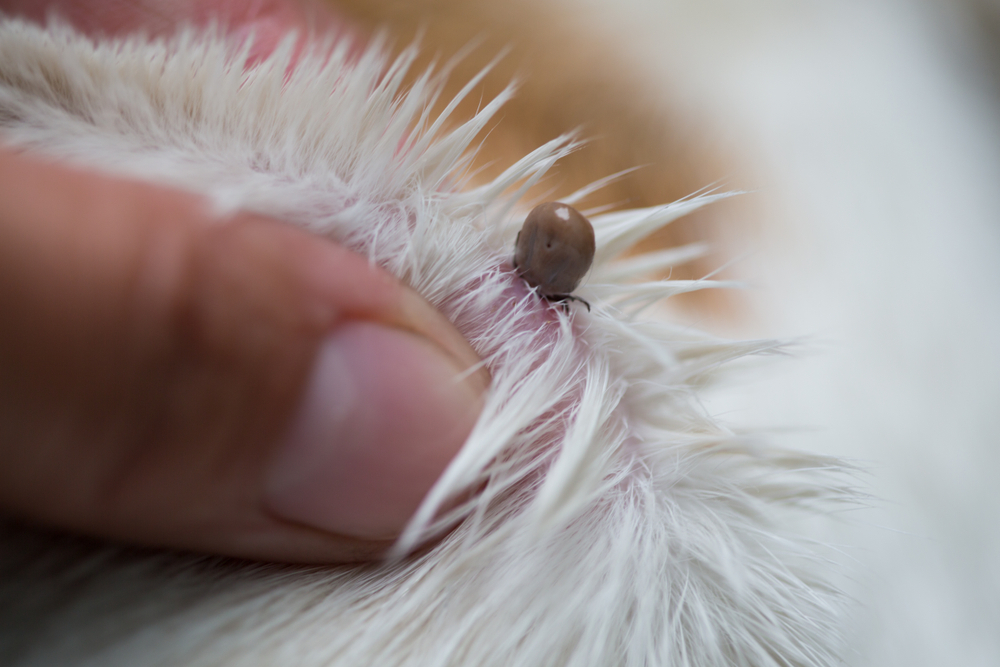Fleas and ticks can be quite a nuisance, but they can also transmit dangerous diseases to your family—both human and furry. Understanding how they grow, as well as how to prevent and treat potential infestations, can help keep everyone in your home safe.
What are fleas and ticks?
Fleas are insects that live on and around animals, feeding on their blood to survive. Ctenocephalides felis (cat flea) is the most common species found on dogs and cats, but there are nearly 2,000 different flea species. If you see fleas on your pet, prompt action is required to head off a full-blown infestation, prevent the spread of disease, and keep your pet comfortable.
Ticks are also external parasites, but they are arachnids, not insects. There are approximately 80 different tick species, with Ixodes scapularis (deer tick), Rhipicephalus sanguineus (brown dog tick), and Dermacentor variabilis (American dog tick) most commonly seen in the United States. Prevention is crucial, as ticks can spread life-threatening diseases to pets and people.

Life cycles of fleas and ticks
The fleas that you can see—adult fleas—account for only 5 percent of the total flea population in an environment. The other 95 percent are flea eggs (50%), larvae (35%), and pupae (10%) that are living and developing in your home and on your pet.
Ticks also go through four different life stages: egg, larva, nymph, and adult. After a tick egg hatches, it will require a blood meal to survive and to transition to the next life stage. The entire life cycle of a tick can take up to 3 years.
Consequences of infestation
The small amount of saliva that a flea leaves behind when it bites causes an itchy reaction. With constant scratching and chewing, secondary bacterial and fungal infections commonly develop. Some pets have an allergy to flea bites, known as flea allergy dermatitis (FAD). This severe reaction is often sparked by the bite of a single flea.
Fleas can transmit tapeworms if ingested, which often happens when pets groom themselves. Tapeworms are intestinal parasites that release segments resembling white rice in the stool. Tapeworms rarely cause significant harm, however severe infestations can result in weight loss and intestinal blockages. Since fleas feed on the blood of their host, a large flea infestation can cause anemia. In extreme cases, significant blood loss can cause death in small dogs and cats.
Tick saliva has anesthetic properties, making their bites painless. This allows a tick to remain attached and feed on its host’s blood for several days at a time. Ticks can transmit several diseases, such as Lyme disease, ehrlichiosis, and Rocky Mountain Spotted Fever, to animals and people. These diseases are treatable but have the potential to cause serious complications if left untreated.
Treatment methods
The first priority to treating a flea infestation is to kill adult fleas on your pet. There are many safe products our veterinary team can suggest that will do the job quickly. Treatment of all pets in the household is necessary, even if not all of them go outside. The flea eggs, larvae, and pupae in the environment must also be eliminated to prevent re-infestation. Tips for environmental treatment:
- Vacuum all carpets, hard floors, and furniture every 2–3 days to manually remove immature stages. Don’t forget to vacuum under and behind furniture, where your pet may hide or sleep. Empty the vacuum canister immediately in a trash can outside to prevent fleas from escaping back into your home.
- Launder all bedding where your pet naps at least once a week. Be sure to include all blankets, pillows, and bedding.
- If you still see fleas after several rounds of aggressive cleaning, contact us for recommendations of environmental treatments that will be safe for all people and pets in your home.
If you find a tick on your pet, you will need to remove it or bring her into our hospital for removal. To remove a tick, grasp the head with tweezers and gently pull it out. Never apply heat or chemicals to a tick to encourage it to back out on its own—you can burn your pet, and traumatizing a tick increases the likelihood of disease transmission.
Preventing fleas and ticks
To reduce your pet’s risk of becoming a host to these pesky parasites, use a year-round flea and tick preventive. Speak with our team about the preventive product that would be best for your pet.
Always check your pet for fleas and ticks after spending time outdoors, especially in areas that are heavily wooded or have tall grasses, which are prime locations for these parasites to hitch a ride on you or your furry friend.
Questions about fleas and ticks? Call us at 508-528-1135.
